Towards Measuring and Visualizing Sustainable National Power—A Case Study of China and Neighboring Countries
Abstract
:1. Introduction
2. Definition of Sustainable National Power
3. Related Work
3.1. Measuring Comprehensive National Power
| Source | Year | Formula Description |
|---|---|---|
| German [17] | 1960 | Power = N × (L + P + I + M), |
| Where N = nuclear capability, L = land, I = industrial base, and M = military. | ||
| Cline [11] | 1975 | Power = (C + E + M) × (S + W), |
| Where C = critical mass (population and territory), E = economic capability, M = military capability, S = strategic purpose, and W = national will. | ||
| Matto [4] | 1977 | Power = (C + E + M) × (S + W + P), |
| Where C = critical mass (population and territory), E = economic capacity, M = military capacity, S = strategic concepts held by a state, W = national will, and P = capacity to persuade or convince. | ||
| Small and Singer [18] | 1982 | Power = (ME + AF + IP + EC + UP + TP)/6 |
| Where ME = military expenditure, AF = armed forces personnel, IP = iron production, EC = energy consumption, UP = urban population, and TP = total population. | ||
| Kadera and Sorokin [1] | 2004 | Power = (ME × AF × IP ×EC × UP ×TP)1/6, |
| Where symbols are the same as Small and Singer’s model above. | ||
| Chang [19] | 2004 | |
| Where CM = critical mass (population + land area), E = economic strength, and M = military strength. | ||
| Hafeznia et al. [9] | 2008 | Power = EC + PL + CL + SC + MI + TR + ST + TN + AS, |
| Where EC = economical factor, PL = political factor, CL = cultural factor, SC = social factor, MI = military factor, TR = territorial factor, ST = scientific and technological factor, TN = trans-national factor, and AS = astro space factor. | ||
| Yan [20] | 2008 | Power = (M + E + C) × P, |
| Where M = military power, E = economic power, C = cultural power, and P = political power. |
3.2. Measuring Sustainable Development and Competitiveness
4. Measuring Sustainable National Power
4.1. Framework of SNP Measurement
4.2. Measuring CNP
- Critical mass (CM). Adopted from Cline’s model, critical mass contains the very basic variables to form power: land, population, resources and energy.
- Technological strength (T). With the development of technology, it has become increasingly important for economic and military growth. We consider technological strength as an essential dimension of national power though it has been emphasized by only a few studies (e.g., [9]). We select R&D expenditure, number of researchers, scientific papers and patent applications as indicators to measure technological strength.
- Military strength (M). Military expenditure, armed forces personnel and nuclear capability are most frequently used indicators of military strength and thus are adopted in our model. In addition, we select arms imports and exports to represent the level of arms development.
- Cultural appeal (CA). It cannot be ignored that the influence of a nation’s culture is becoming increasingly significant. We consider cultural appeal as a dimension of comprehensive national power as Yan [20] and Hafeznia et al. [9] did. We use several indicators to measure cultural appeal involving the number of feature films, Olympic medals, world heritage sites, international fairs and exhibitions, and international students.
| Critical Mass (CM) | Economic Strength (C) | Military (M) |
|---|---|---|
|
|
|
|
| |
|
| |
|
| |
| Technological Strength (T) | Cultural Appeal (CA) | |
|
| |
|
| |
|
| |
|
| |
|
4.3. Measuring SNP-Adjusted Index
4.3.1. Calculation of SNP-Adjusted Index
4.3.2. Calculation of Social-Adjusted Index
- Healthy and decent life. A key element of a country’s power is its people. As stated by Merritt, “A healthy, skilled population may be a capability; an equally large but disease-ridden and illiterate population can be a load on a government's capacities” (p. 143 in [29]). A high income and improved sanitation facilities are basic requirements for a healthy and decent life. Obviously, a high standard of living will naturally expect a long life expectancy.
- Education. Education is a prerequisite for individuals to master basic living skills. Furthermore, good quality of higher education plays the fundamental role in an innovative society. We use years of schooling and literacy rate to represent basic level of education. Particularly, we adopt tertiary school enrollment to measure the potential of education to creativity and technology for a country. In addition, expenditure on education is included because it is the guarantee of educational resources and facilities.
- Well-balanced society. A well-balanced society consists of a number of elements. Government performance is a prominent one. We select the Worldwide Governance Indicators (WGI) developed by World Bank [30] to measure governance. The WGI is a composite index measured by six dimensions of governance (namely, voice and accountability, political stability and absence of violence, government effectiveness, regulatory quality, rule of law, and control of corruption). Other most relevant indicators such as gender inequality, poverty, unemployment, population growth, and aging population are also included to measure the society dimension.
| Healthy and Decent life | Education | Well-Balanced Society |
|---|---|---|
|
|
|
|
|
|
|
|
|
|
| |
|
| |
|
4.3.3. Calculation of Environmental-Adjusted Index
- Renewable resources. Efficient use of renewable resources can benefit our future generations by decreasing traditional fossil energy depletion and reducing greenhouse gas emissions. Promoting uses of renewable resources can also facilitate new technique development and initiate new markets. Balancing the use of renewable and non-renewable resources to meet present’s needs while support next generations plays a critical role in environmental sustainability. Here we use renewable energy consumption, renewable freshwater resources and renewable source supply to measure this dimension.
- Natural resources and biodiversity. Biodiversity provides raw materials for our daily life and supports economic growth. It is also the key to maintain the stability of the planet ecosystem. Here, we use a composite indicator to measure the biodiversity potential.
- Carbon reduction. Climate change has posed great challenges on human beings such as global warming and extreme weather events [31,32]. In its latest report, the Intergovermental Panel on Climate Change (IPCC) concluded that the global mean-surface temperature increased 0.85 degree from 1880 to 2012 and that the increase of carbon dioxide (CO2) emissions in the atmosphere is the main driving force [33]. Responding to climate change requires intergovernmental cooperation, but individual counties should take corresponding responsibilities. Developing countries should keep a good balance between economic development and greenhouse gas emissions. Here, we use CO2 emissions to measure the level of a nation’s carbon reduction.
| Renewable Resources | Natural Resources and Biodiversity | Carbon Reduction |
|---|---|---|
|
|
|
|
| |
|
|
5. Visualizing Power Using Density-Equalizing Maps
6. A Case Study
6.1. Study Area
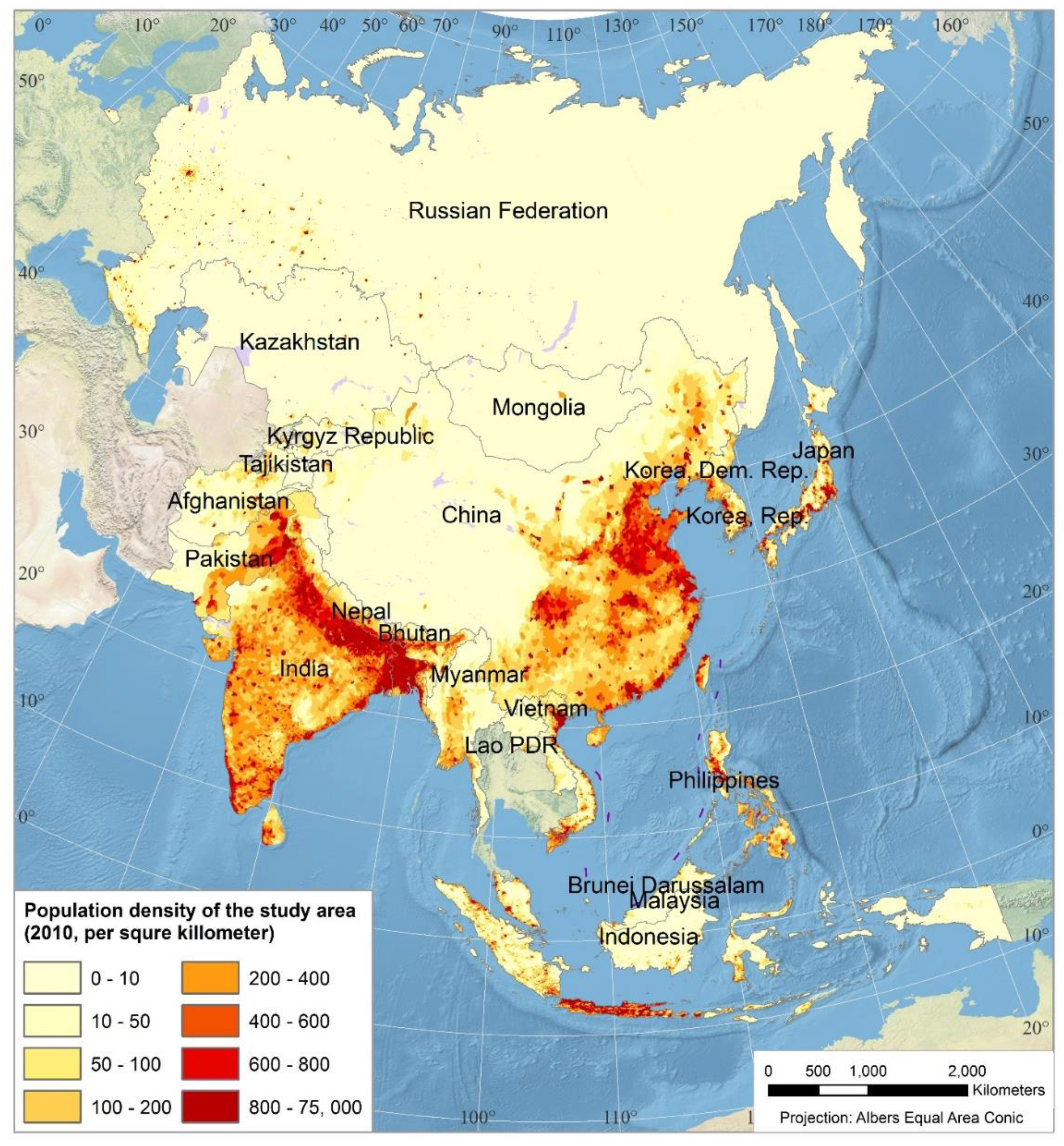
6.2. Data and Software
6.3. Results
6.3.1. Power Distributions in Conceptual Spaces
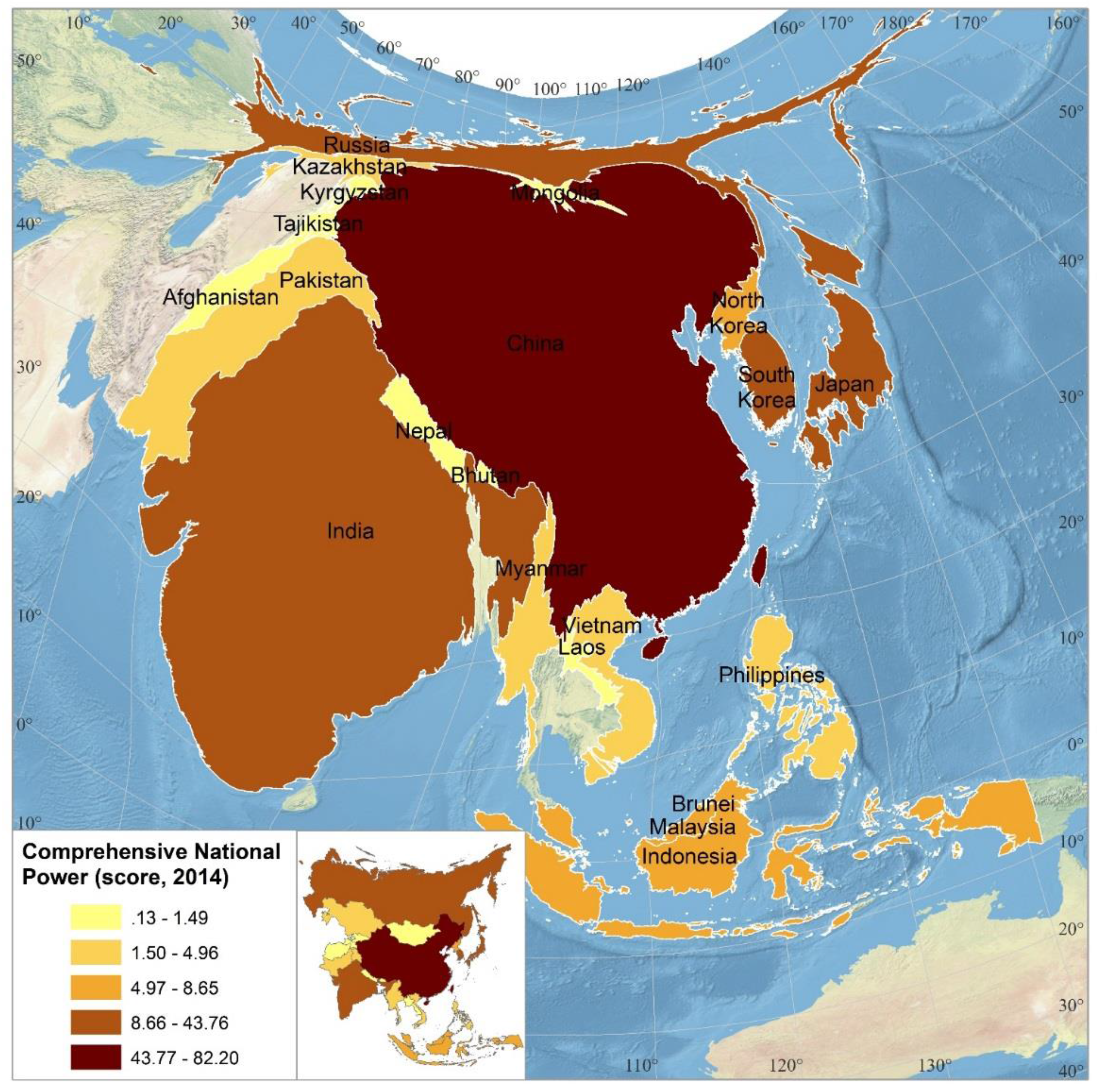
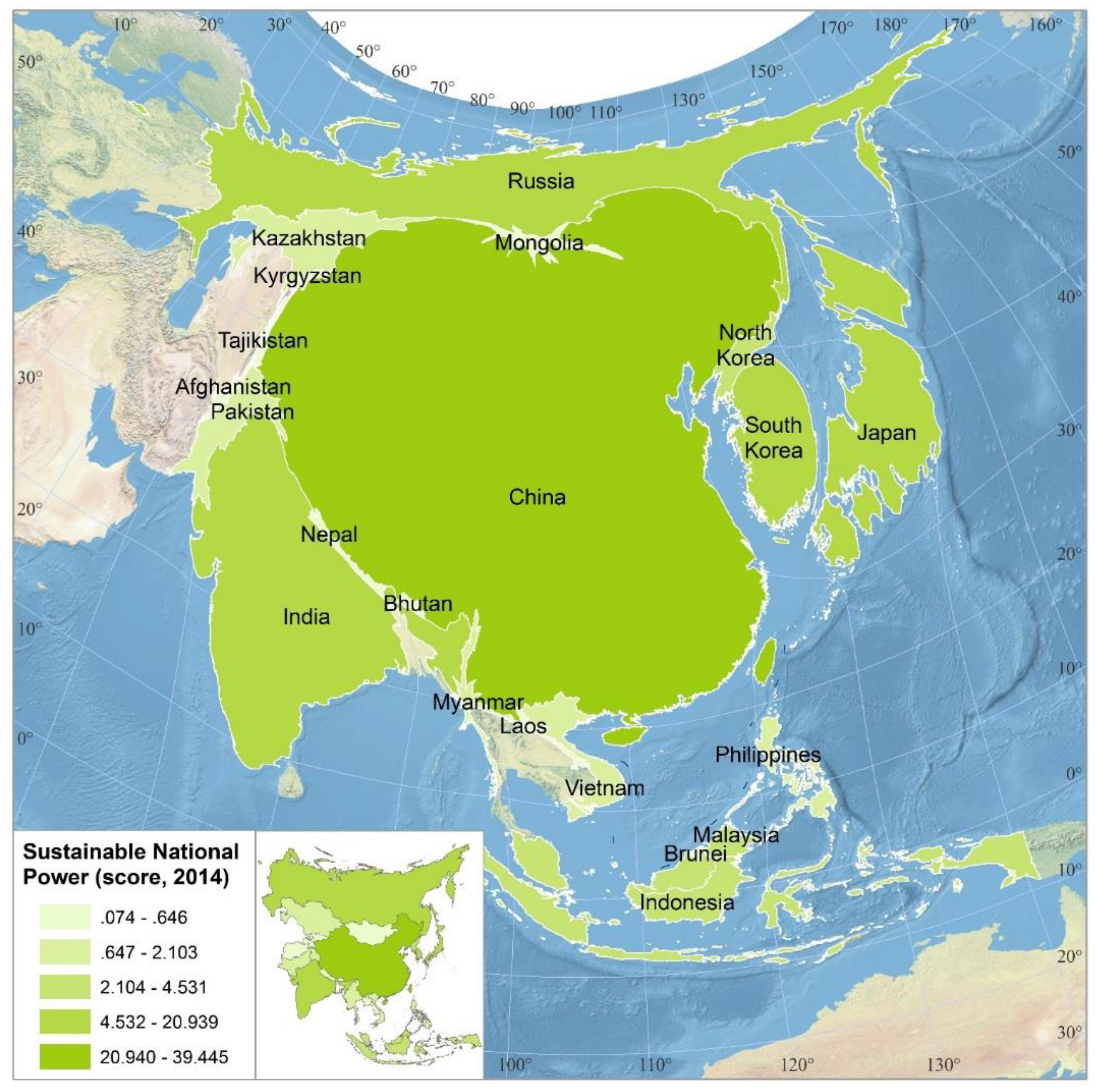
| Country | CNP | SNP-Adjusted Index | SNP | |||
|---|---|---|---|---|---|---|
| Score | Rank | Score | Rank | Score | Rank | |
| China | 81.03 | 1 | 0.53 | 10 | 42.58 | 1 |
| Japan | 39.86 | 3 | 0.60 | 1 | 23.74 | 2 |
| Russian Federation | 45.55 | 2 | 0.49 | 13 | 22.35 | 3 |
| Korea, Rep. | 23.19 | 5 | 0.58 | 2 | 13.35 | 4 |
| India | 30.02 | 4 | 0.43 | 17 | 12.93 | 5 |
| Indonesia | 8.52 | 6 | 0.56 | 6 | 4.76 | 6 |
| Malaysia | 7.13 | 7 | 0.57 | 4 | 4.06 | 7 |
| Korea, Dem. Rep. | 5.09 | 9 | 0.45 | 15 | 2.29 | 8 |
| Vietnam | 3.92 | 11 | 0.57 | 5 | 2.22 | 9 |
| Pakistan | 5.09 | 8 | 0.37 | 18 | 1.90 | 10 |
| Philippines | 2.82 | 12 | 0.54 | 9 | 1.52 | 11 |
| Kazakhstan | 4.11 | 10 | 0.35 | 19 | 1.42 | 12 |
| Myanmar | 2.16 | 13 | 0.52 | 12 | 1.12 | 13 |
| Mongolia | 1.48 | 14 | 0.43 | 16 | 0.64 | 14 |
| Nepal | 0.85 | 16 | 0.48 | 14 | 0.41 | 15 |
| Afghanistan | 1.28 | 15 | 0.29 | 20 | 0.37 | 16 |
| Kyrgyz Republic | 0.68 | 17 | 0.54 | 8 | 0.37 | 17 |
| Lao PDR | 0.41 | 19 | 0.52 | 11 | 0.21 | 18 |
| Tajikistan | 0.35 | 20 | 0.55 | 7 | 0.19 | 19 |
| Brunei Darussalam | 0.50 | 18 | 0.29 | 21 | 0.14 | 20 |
| Bhutan | 0.13 | 21 | 0.57 | 3 | 0.07 | 21 |
| Country | Critical Mass | Economic Strength | Technological Strength | Military Strength | Cultural Appeal | |||||
|---|---|---|---|---|---|---|---|---|---|---|
| Score | Rank | Score | Rank | Score | Rank | Score | Rank | Score | Rank | |
| China | 89.33 | 1 | 100.00 | 1 | 74.52 | 1 | 61.84 | 2 | 79.43 | 1 |
| Russian Federation | 62.64 | 2 | 17.94 | 4 | 21.45 | 4 | 73.04 | 1 | 52.68 | 3 |
| India | 38.29 | 3 | 19.94 | 3 | 10.41 | 5 | 40.89 | 3 | 40.57 | 4 |
| Indonesia | 14.84 | 4 | 8.56 | 6 | 0.70 | 11 | 8.26 | 8 | 10.23 | 7 |
| Kazakhstan | 10.01 | 5 | 2.03 | 10 | 2.82 | 7 | 1.22 | 15 | 4.49 | 10 |
| Pakistan | 5.68 | 6 | 2.37 | 9 | 1.04 | 9 | 13.04 | 6 | 3.34 | 12 |
| Malaysia | 3.83 | 7 | 3.14 | 7 | 8.13 | 6 | 3.14 | 12 | 17.40 | 6 |
| Vietnam | 3.72 | 8 | 1.78 | 11 | 0.71 | 10 | 6.36 | 10 | 7.05 | 8 |
| Japan | 3.49 | 9 | 44.41 | 2 | 72.97 | 2 | 10.33 | 7 | 68.13 | 2 |
| Philippines | 2.97 | 10 | 2.73 | 8 | 0.48 | 13 | 1.95 | 13 | 5.98 | 9 |
| Myanmar | 2.90 | 11 | 0.60 | 12 | 0.01 | 16 | 6.85 | 9 | 0.41 | 18 |
| Mongolia | 2.79 | 12 | 0.10 | 16 | 0.02 | 15 | 0.20 | 20 | 4.32 | 11 |
| Afghanistan | 2.07 | 13 | 0.18 | 13 | 0.00 | 21 | 4.02 | 11 | 0.13 | 20 |
| Korea, Rep. | 1.55 | 14 | 13.60 | 5 | 45.49 | 3 | 15.15 | 5 | 40.15 | 5 |
| Korea, Dem. Rep. | 1.16 | 15 | 20 | 0.64 | 12 | 15.46 | 4 | 3.09 | 13 | |
| Nepal | 0.84 | 16 | 0.17 | 14 | 0.29 | 14 | 1.36 | 14 | 1.61 | 15 |
| Lao PDR | 0.74 | 17 | 0.10 | 17 | 0.01 | 18 | 1.11 | 16 | 0.08 | 21 |
| Brunei Darussalam | 0.49 | 18 | 0.15 | 15 | 1.13 | 8 | 0.32 | 17 | 0.41 | 19 |
| Kyrgyz Republic | 0.42 | 19 | 0.05 | 19 | 0.01 | 17 | 0.22 | 18 | 2.72 | 14 |
| Tajikistan | 0.35 | 20 | 0.07 | 18 | 0.01 | 19 | 0.21 | 19 | 1.10 | 16 |
| Bhutan | 0.09 | 21 | 0.00 | 20 | 0.00 | 20 | 0.00 | 21 | 0.56 | 17 |
| Country | Healthy and Decent Life | Education | Well-balanced Society | Social-Adjusted SNP Index | ||||
|---|---|---|---|---|---|---|---|---|
| Score | Rank | Score | Rank | Score | Rank | Score | Rank | |
| Korea, Rep. | 0.93 | 2 | 0.93 | 1 | 0.68 | 4 | 0.85 | 1 |
| Japan | 1.00 | 1 | 0.73 | 4 | 0.53 | 14 | 0.75 | 2 |
| Malaysia | 0.71 | 4 | 0.67 | 7 | 0.80 | 1 | 0.73 | 3 |
| Brunei Darussalam | 0.79 | 3 | 0.61 | 8 | 0.75 | 2 | 0.72 | 4 |
| Kazakhstan | 0.64 | 5 | 0.72 | 6 | 0.66 | 7 | 0.67 | 5 |
| Russian Federation | 0.54 | 7 | 0.80 | 2 | 0.53 | 13 | 0.63 | 6 |
| Kyrgyz Republic | 0.44 | 10 | 0.72 | 5 | 0.60 | 8 | 0.59 | 7 |
| Vietnam | 0.46 | 9 | 0.58 | 11 | 0.68 | 5 | 0.57 | 8 |
| Mongolia | 0.30 | 15 | 0.74 | 3 | 0.67 | 6 | 0.57 | 9 |
| China | 0.48 | 8 | 0.60 | 9 | 0.59 | 9 | 0.55 | 10 |
| Tajikistan | 0.41 | 12 | 0.59 | 10 | 0.54 | 12 | 0.51 | 11 |
| Philippines | 0.38 | 13 | 0.53 | 13 | 0.55 | 10 | 0.49 | 12 |
| Korea, Dem. Rep. | 0.57 | 6 | 0.40 | 21 | 0.49 | 13 | ||
| Indonesia | 0.36 | 14 | 0.54 | 12 | 0.49 | 17 | 0.46 | 14 |
| Bhutan | 0.24 | 17 | 0.28 | 17 | 0.70 | 3 | 0.40 | 15 |
| Myanmar | 0.43 | 11 | 0.25 | 18 | 0.52 | 15 | 0.40 | 16 |
| Lao PDR | 0.30 | 16 | 0.31 | 16 | 0.55 | 11 | 0.38 | 17 |
| Nepal | 0.15 | 19 | 0.37 | 14 | 0.50 | 16 | 0.34 | 18 |
| India | 0.14 | 20 | 0.34 | 15 | 0.48 | 18 | 0.32 | 19 |
| Pakistan | 0.20 | 18 | 0.12 | 19 | 0.47 | 19 | 0.26 | 20 |
| Afghanistan | 0.00 | 21 | 0.09 | 20 | 0.46 | 20 | 0.18 | 21 |
| Country | Renewable Resources | Natural Resources and Biodiversity | Carbon Reduction | Environmental-Adjusted Index | ||||
|---|---|---|---|---|---|---|---|---|
| Score | Rank | Score | Rank | Score | Rank | Score | Rank | |
| Bhutan | 1.00 | 1 | 0.48 | 11 | 0.97 | 6 | 0.82 | 1 |
| Lao PDR | 0.62 | 4 | 0.52 | 9 | 1.00 | 2 | 0.71 | 2 |
| Nepal | 0.68 | 2 | 0.39 | 12 | 1.00 | 1 | 0.69 | 3 |
| Indonesia | 0.30 | 7 | 0.82 | 1 | 0.91 | 12 | 0.68 | 4 |
| Myanmar | 0.67 | 3 | 0.34 | 14 | 1.00 | 3 | 0.67 | 5 |
| Philippines | 0.28 | 8 | 0.54 | 7 | 0.97 | 7 | 0.60 | 6 |
| Tajikistan | 0.47 | 5 | 0.33 | 15 | 0.99 | 4 | 0.60 | 7 |
| India | 0.26 | 10 | 0.55 | 6 | 0.94 | 10 | 0.58 | 8 |
| Vietnam | 0.25 | 11 | 0.49 | 10 | 0.92 | 11 | 0.56 | 9 |
| Pakistan | 0.32 | 6 | 0.32 | 16 | 0.97 | 8 | 0.54 | 10 |
| Kyrgyz Republic | 0.27 | 9 | 0.27 | 18 | 0.96 | 9 | 0.50 | 11 |
| China | 0.12 | 13 | 0.65 | 3 | 0.72 | 14 | 0.50 | 12 |
| Japan | 0.05 | 20 | 0.75 | 2 | 0.62 | 17 | 0.47 | 13 |
| Afghanistan | 0.07 | 18 | 0.34 | 13 | 0.99 | 5 | 0.46 | 14 |
| Malaysia | 0.11 | 15 | 0.55 | 5 | 0.68 | 16 | 0.44 | 15 |
| Korea, Dem. Rep. | 0.11 | 14 | 0.26 | 19 | 0.88 | 13 | 0.42 | 16 |
| Korea, Rep. | 0.07 | 16 | 0.59 | 4 | 0.51 | 18 | 0.39 | 17 |
| Russian Federation | 0.14 | 12 | 0.53 | 8 | 0.48 | 19 | 0.38 | 18 |
| Mongolia | 0.07 | 17 | 0.19 | 20 | 0.72 | 15 | 0.33 | 19 |
| Kazakhstan | 0.02 | 21 | 0.17 | 21 | 0.34 | 20 | 0.18 | 20 |
| Brunei Darussalam | 0.06 | 19 | 0.28 | 17 | 0.00 | 21 | 0.11 | 21 |
6.3.2. Strength Changes Overtime: Power Redistribution
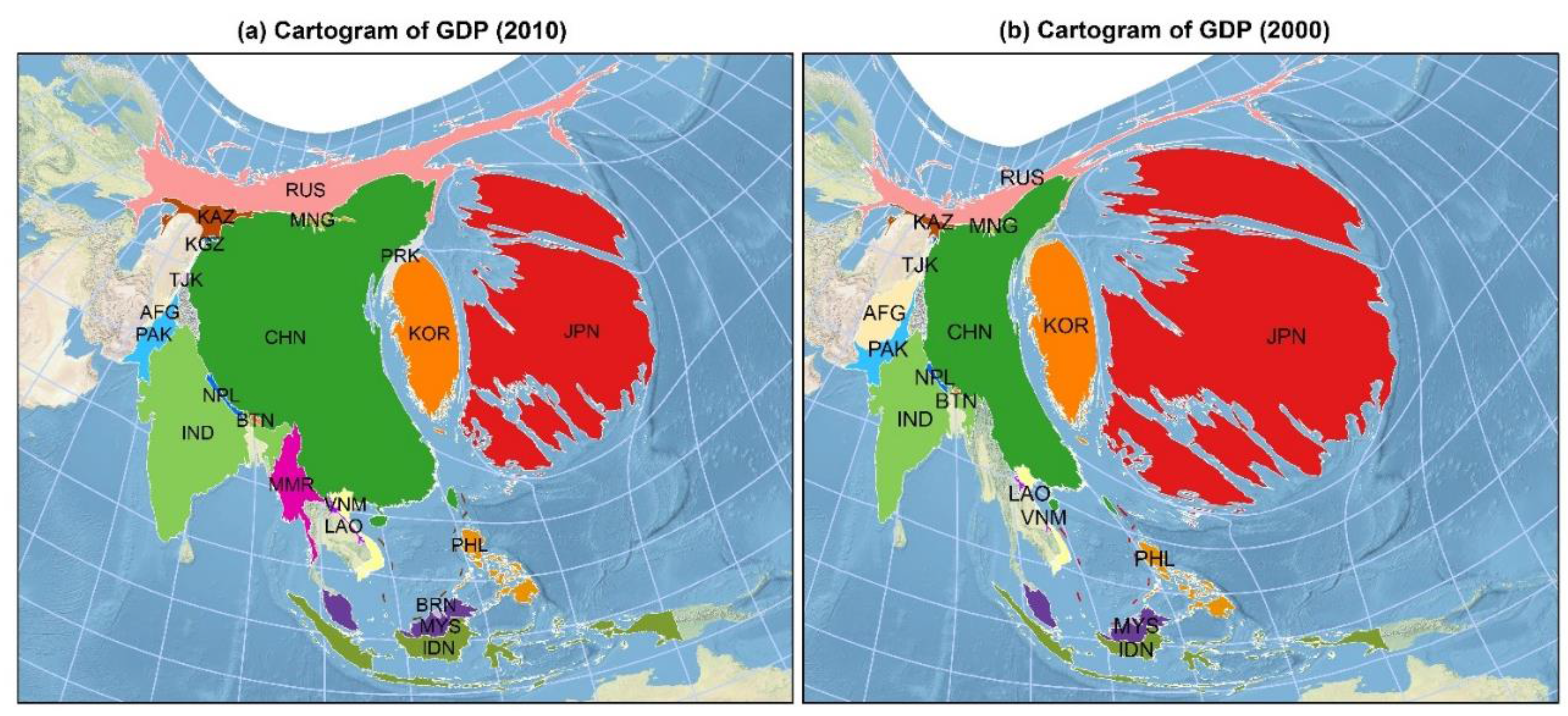
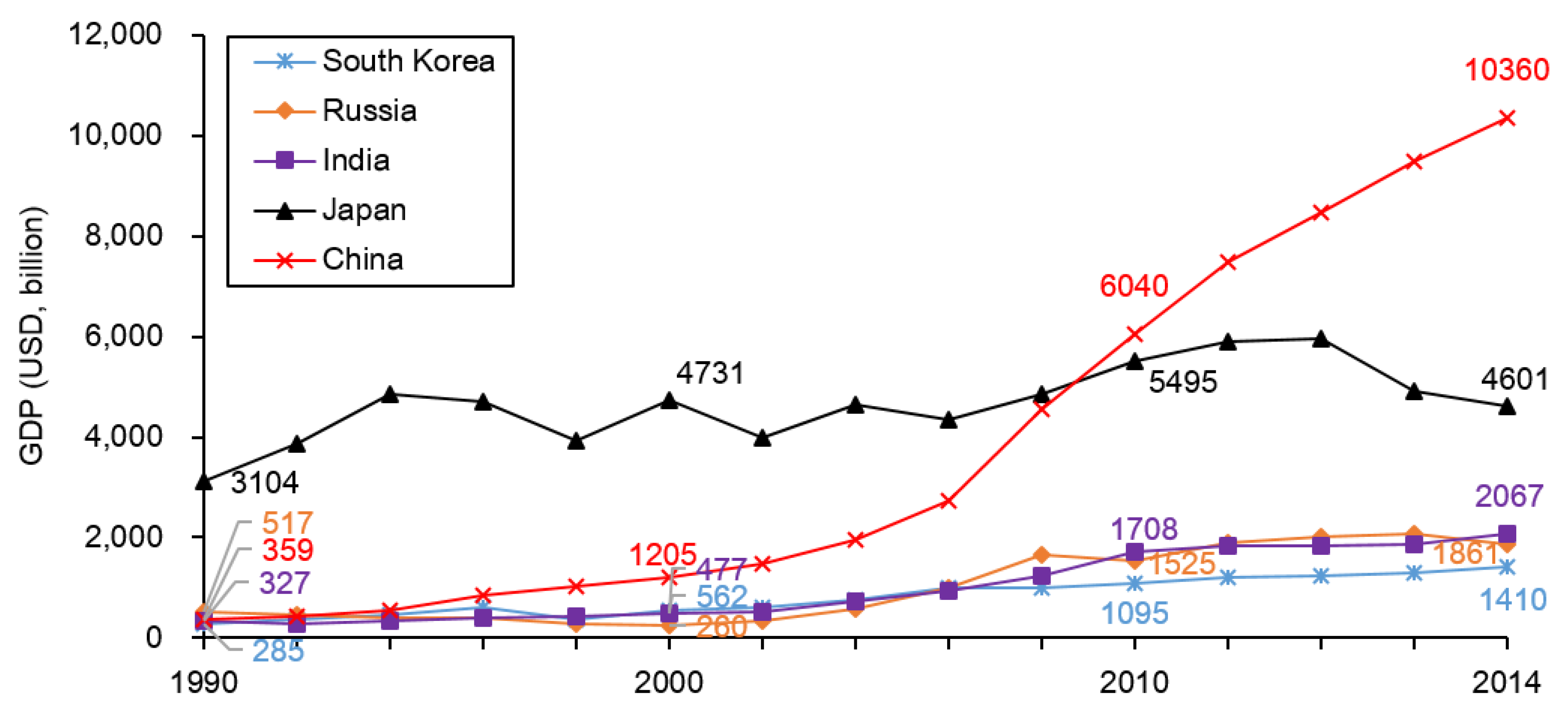
7. General Discussion
7.1. Re-Visualizing Borders in Conceptual Spaces
7.2. Effectiveness of Cartogram for Cartographic Communication
8. Conclusions
Supplementary Files
Supplementary File 1Acknowledgments
Author Contributions
Conflicts of Interest
References
- Kadera, K.; Sorokin, G. Measuring national power. Int. Interact. 2004, 30, 211–230. [Google Scholar] [CrossRef]
- Thompson, K.; Morgenthau, H. Politics Among Nations: The Struggle for Power and Peace; Alfred, A., Ed.; Knopf: New York, NY, USA, 1985. [Google Scholar]
- Mearsheimer, J.J. The Tragedy of Great Power Politics; WW Norton & Company: New York, NY, USA, 2001. [Google Scholar]
- Mattos, M.; Viana, L. A Geopolítica e as Projeções do Poder; Biblioteca do Exército: Rio de Janeiro, Brazil, 1977. [Google Scholar]
- Kelly, P.L. Geopolitical themes in the writings of general carlos de meira mattos of brazil. J. Lat. Am. Stud. 1984, 16, 439–461. [Google Scholar] [CrossRef]
- WCED. Our Common Future; WCED: New York, NY, USA, 1987. [Google Scholar]
- WEF. Assessing progress toward sustainable competitiveness. In The Global Competitiveness Report 2014-2015; WEF: Geneva, Switzerland, 2014; pp. 53–83. [Google Scholar]
- Höhn, K.H. Geopolitics and the Measurement of National Power. Ph.D. Thesis, der Universität Hamburg, Hamburg, Germany, 2014. [Google Scholar]
- Hafeznia, M.R.; Hadi Zarghani, S.; Ahmadipor, Z.; Roknoddin Eftekhari, A. Presentation a new model to measure national power of the countries. J. Appl. Sci. 2008, 8, 230–240. [Google Scholar] [CrossRef]
- Hart, J. Three approaches to the measurement of power in international relations. Int. Organ. 1976, 30, 289–305. [Google Scholar] [CrossRef]
- Cline, R.S. World Power Assessment: A Calculus of Strategic Drift; Westview Press: Boulder, CO, USA, 1975. [Google Scholar]
- Chan, S. Is there a power transition between the us and China? The different faces of national power. Asian Surv. 2005, 45, 687–701. [Google Scholar] [CrossRef]
- Treverton, G.F.; Jones, S.G. Measuring National Power; DTIC: Fairfax City, VA, USA, 2005. [Google Scholar]
- Hwang, K. New thinking in measuring national power. In Proceedings of the 2nd Global International Studies Conference, Ljubljana, Slovenia, 20 July 2008; pp. 23–26.
- Nye, J. Notes for a soft power research agenda. In Power in World Politics; Routledge: Oxford, UK; New York, NY, USA, 2007; pp. 162–172. [Google Scholar]
- Nye, J.S. Soft Power: The Means to Success in World Politics; Public Affairs: New York, NY, USA, 2004. [Google Scholar]
- German, F.C. A tentative evaluation of world power. J. Confl. Resolut. 1960, 4, 138–144. [Google Scholar] [CrossRef]
- Small, M.; Singer, J.D. Resort to Arms: International and Civil Wars, 1816–1980; Sage Publications, Inc.: Los Angeles, CA, USA, 1982. [Google Scholar]
- Chang, C.L. A measure of national power. In Proceedings of the 2004 International Seminar at the National University of Malaysia, Bangi, Malaysia, 16–17 February 2004; pp. 16–17.
- Xuetong, Y. Xun zi’s thoughts on international politics and their implications. Chin. J. Int. Politics 2008, 2, 135–165. [Google Scholar] [CrossRef]
- WEF. The Global Competitiveness Report 2014–2015; World Economic Forum: Geneva, Switzerland, 2014. [Google Scholar]
- UNDP. Human Development Report 2014. Sustaining Human Progress: Reducing Vulnerabilities and Building Resilience; UNDP: New York, NY, USA, 2014. [Google Scholar]
- Van de Kerk, G.; Manuel, A.R. A comprehensive index for a sustainable society: The ssi—The sustainable society index. Ecol. Econ. 2008, 66, 228–242. [Google Scholar] [CrossRef]
- McLellan, R.; Iyengar, L.; Jeffries, B.; Oerlemans, N. Living Planet Report 2014: Species and Spaces, People and Places. Available online: http://apo.org.au/node/41529 (accessed on 2 August 2015).
- United Nations. The Millennium Development Goals Report 2014; United Nations: New York, NY, USA, 2014. [Google Scholar]
- Davis, K. Population and power in the free world. In Population Theory And Policy. Selected Readings; Free Press of Glencoe: Glencoe, Illinois, 1958; pp. 342–356. [Google Scholar]
- Casetti, E. Power shifts and economic development: When will China overtake the USA? J. Peace Res. 2003, 40, 661–675. [Google Scholar] [CrossRef]
- UNDP. Technical Notes of Human Development Index. Available online: http://hdr.undp.org/sites/default/files/hdr14_technical_notes.pdf (accessed on 25 July 2015).
- Merritt, R.L.; Zinnes, D.A. Validity of power indices. Int. Interact. 1988, 14, 141–151. [Google Scholar] [CrossRef]
- Kaufmann, D.; Kraay, A.; Mastruzzi, M. The worldwide governance indicators: Methodology and analytical issues. Hague J. Rule Law 2011, 3, 220–246. [Google Scholar] [CrossRef]
- Dong, W.; Liu, Z.; Liao, H.; Tang, Q.; Li, X.E. New climate and socio-economic scenarios for assessing global human health challenges due to heat risk. Clim. Change 2015, 4, 505–518. [Google Scholar] [CrossRef]
- Dong, W.; Liu, Z.; Zhang, L.; Tang, Q.; Liao, H.; Li, X.E. Assessing heat health risk for sustainability in Beijing’s urban heat island. Sustainability 2014, 6, 7334–7357. [Google Scholar] [CrossRef]
- IPCC. Summary for Policymakers; IPCC: 1202 Genève, Switzerland.
- Lobben, A.K. Tasks, strategies, and cognitive processes associated with navigational map reading: A review perspective. Prof. Geogr. 2004, 56, 270–281. [Google Scholar]
- Dorling, D. Map design for census mapping. Cartogr. J. 1993, 30, 167–183. [Google Scholar] [CrossRef]
- Gastner, M.T.; Newman, M.E. Diffusion-based method for producing density-equalizing maps. Proc. Natl. Acad. Sci. USA 2004, 101, 7499–7504. [Google Scholar] [CrossRef] [PubMed]
- Tobler, W. Thirty five years of computer cartograms. ANNALS Assoc. Am. Geogr. 2004, 94, 58–73. [Google Scholar] [CrossRef]
- Webb, R. Cartography: A popular perspective. Nature 2006, 439, 800–800. [Google Scholar] [CrossRef] [PubMed]
- Butler, D. Swollen with success. Nature 2008, 455, 270–271. [Google Scholar] [CrossRef] [PubMed]
- Raisz, E. The rectangular statistical cartogram. Geogr. Rev. 1934, 24, 292–296. [Google Scholar] [CrossRef]
- Gastner, M.T.; Shalizi, C.R.; Newman, M.E. Maps and cartograms of the 2004 US presidential election results. Adv. Complex Syst. 2005, 8, 117–123. [Google Scholar] [CrossRef]
- Dorling, D.; Barford, A.; Newman, M. Worldmapper: The world as you’ve never seen it before. IEEE Trans. Visual. Comput. Graph. 2006, 12, 757–764. [Google Scholar] [CrossRef] [PubMed]
- Hennig, B. Rediscovering the World: Map Transformations of Human and Physical Space; Springer: Berlin, Germany, 2012. [Google Scholar]
- Hennig, B.D. The human planet. Environ. Plan. A 2013, 45, 489–491. [Google Scholar] [CrossRef]
- Hennig, B.D. Gridded cartograms as a method for visualising earthquake risk at the global scale. J. Maps 2014, 10, 186–194. [Google Scholar] [CrossRef]
- Li, L.; Clarke, K.C. Cartograms showing China’s population and wealth distribution. J. Maps 2012, 8, 320–323. [Google Scholar] [CrossRef]
- Reyes Nuñez, J.J. The use of cartograms in school cartography. Themat. Cartogr. Soc. 2014, 327–339. [Google Scholar]
- Houle, B.; Holt, J.; Gillespie, C.; Freedman, D.S.; Reyes, M. Use of density-equalizing cartograms to visualize trends and disparities in state-specific prevalence of obesity: 1996–2006. Am. J. Public Health 2009, 99, 308–312. [Google Scholar] [CrossRef] [PubMed]
- Khalakdina, A.; Selvin, S.; Merrill, D.W.; Erdmann, C.A.; Colford, J.M., Jr. Analysis of the spatial distribution of cryptosporidiosis in aids patients in san francisco using density equalizing map projections (demp). Int. J. Hyg. Environ. Health 2003, 206, 553–561. [Google Scholar] [CrossRef] [PubMed]
- Kusma, B.; Scutaru, C.; Quarcoo, D.; Welte, T.; Fischer, T.C.; Groneberg-Kloft, B. Tobacco control: Visualisation of research activity using density-equalizing mapping and scientometric benchmarking procedures. Int. J. Environ. Res. Public Health 2009, 6, 1856–1869. [Google Scholar] [CrossRef] [PubMed]
- Selvin, S.; Merrill, D.; Schulman, J.; Sacks, S.; Bedell, L.; Wong, L. Transformations of maps to investigate clusters of disease. Soc. Sci. Med. 1988, 26, 215–221. [Google Scholar] [CrossRef]
- Sui, D.Z.; Holt, J.B. Visualizing and analysing public-health data using value-by-area cartograms: Toward a new synthetic framework. Cartogr. Int. J. Geogr. Inf. Geovisual. 2008, 43, 3–20. [Google Scholar] [CrossRef]
- Spykman, N.J.; Nicholl, H.R. Geography of the Peace; Harcourt: SanDiego, CA, USA, 1944. [Google Scholar]
- WorldBank. China 2030: Building a Modern, Harmonious, and Creative, High-Income Society. Available online: http://www.worldbank.org/content/dam/Worldbank/document/China-2030-complete.pdf (accessed on 7 October).
- Yang, R. Soft power and higher education: An examination of China’s confucius institutes. Global. Soc.Educ. 2010, 8, 235–245. [Google Scholar] [CrossRef]
- Butler, D. China: The great contender. Nature 2008, 454, 382–383. [Google Scholar] [CrossRef] [PubMed]
- WorldBank. World Bank Open Data: Free and Open Access to Data about Development in Countries around the Globe. Available online: http://data.worldbank.org/ (accessed on 14 October 2014).
- WEF. The Travel & Tourism Competitiveness Report 2013; WEF: Geneva, Switzerland, 2013. [Google Scholar]
- IMF. World Economic Outlook Database. Available online: http://www.imf.org/external/pubs/ft/weo/2014/01/weodata/index.aspx (accessed on 14 October 2014).
- Henriques, R.; Bação, F.; Lobo, V. Carto-som: Cartogram creation using self-organizing maps. Int. J. Geogr. Inf. Sci. 2009, 23, 483–511. [Google Scholar] [CrossRef]
- Inoue, R.; Shimizu, E. A new algorithm for continuous area cartogram construction with triangulation of regions and restriction on bearing changes of edges. Cartogr. Geogr. Inf. Sci. 2006, 33, 115–125. [Google Scholar] [CrossRef]
- Keim, D.A.; North, S.C.; Panse, C. Cartodraw: A fast algorithm for generating contiguous cartograms. IEEE Trans. Visual. Comput. Graph. 2004, 10, 95–110. [Google Scholar] [CrossRef] [PubMed]
- Keim, D.A.; Panse, C.; North, S.C. Medial-axis-based cartograms. IEEE Trans. Comput. Graph. Appl. 2005, 25, 60–68. [Google Scholar] [CrossRef]
- Kocmoud, C.; House, D. A constraint-based approach to constructing continuous cartograms. In Proceedings of the 1998 Symposium Spatial Data Handling, Vancouver, Canada, 12–15 July 1998.
- Sun, S. A fast, free-form rubber-sheet algorithm for contiguous area cartograms. Int. J. Geogr. Inf. Sci. 2013, 27, 567–593. [Google Scholar] [CrossRef]
- Dougenik, J.A.; Chrisman, N.R.; Niemeyer, D.R. An algorithm to contruct continuous area cartograms. Prof. Geogr. 1985, 37, 75–81. [Google Scholar] [CrossRef]
- Jackel, C.B. Using arcview to create contiguous and noncontiguous area cartograms. Cartogr. Geogr. Inf. Syst. 1997, 24, 101–109. [Google Scholar] [CrossRef]
- Anselin, L.; Syabri, I.; Kho, Y. Geoda: An introduction to spatial data analysis. Geogr. Anal. 2006, 38, 5–22. [Google Scholar] [CrossRef]
- Gross, T. Cartogram Geoprocessing Tool Version 2. Available online: http://arcscripts.esri.com/details.asp?dbid=15638 (accessed on 14 October 2014).
- Spykman, N.J. America’s Strategy in World Politics: The United States and the Balance of Power; Transaction Publishers: New Jersey, NJ, USA, 1942. [Google Scholar]
- AntiAtlas. Re-Visualizing Border Cartographies through Art: From Lines to Flows and Portals|Gabriel Popescu. Available online: http://www.antiatlas.net/en/2013/09/28/re-visualizing-border-cartographies-through-art-from-lines-to-flows-and-portals-gabriel-popescu/ (accessed on 5 October 2014).
- Sun, H.; Li, Z. Effectiveness of cartogram for the representation of spatial data. Cartogr. J. 2010, 47, 12–21. [Google Scholar] [CrossRef]
- Dent, B.D. Cartography-Thematic Map Design; WCB McGraw-Hill: Boston, MA, USA, 1999. [Google Scholar]
- Rittschof, K.A.; Stock, W.A.; Kulhavy, R.W.; Verdi, M.P.; Johnson, J.T. Learning from cartograms: The effects of region familiarity. J. Geogr. 1996, 95, 50–58. [Google Scholar] [CrossRef]
- Roth, R.E.; Woodruff, A.W.; Johnson, Z.F. Value-by-alpha maps: An alternative technique to the cartogram. Cartogr. J. 2010, 47, 130–140. [Google Scholar] [CrossRef] [PubMed]
© 2015 by the authors; licensee MDPI, Basel, Switzerland. This article is an open access article distributed under the terms and conditions of the Creative Commons Attribution license (http://creativecommons.org/licenses/by/4.0/).
Share and Cite
Liao, H.; Dong, W.; Liu, H.; Ge, Y. Towards Measuring and Visualizing Sustainable National Power—A Case Study of China and Neighboring Countries. ISPRS Int. J. Geo-Inf. 2015, 4, 1672-1692. https://doi.org/10.3390/ijgi4031672
Liao H, Dong W, Liu H, Ge Y. Towards Measuring and Visualizing Sustainable National Power—A Case Study of China and Neighboring Countries. ISPRS International Journal of Geo-Information. 2015; 4(3):1672-1692. https://doi.org/10.3390/ijgi4031672
Chicago/Turabian StyleLiao, Hua, Weihua Dong, Huiping Liu, and Yuejing Ge. 2015. "Towards Measuring and Visualizing Sustainable National Power—A Case Study of China and Neighboring Countries" ISPRS International Journal of Geo-Information 4, no. 3: 1672-1692. https://doi.org/10.3390/ijgi4031672
APA StyleLiao, H., Dong, W., Liu, H., & Ge, Y. (2015). Towards Measuring and Visualizing Sustainable National Power—A Case Study of China and Neighboring Countries. ISPRS International Journal of Geo-Information, 4(3), 1672-1692. https://doi.org/10.3390/ijgi4031672






